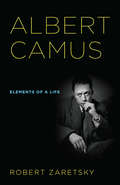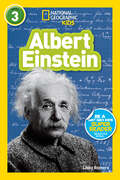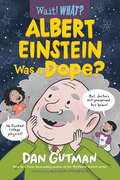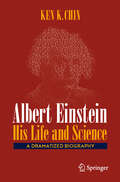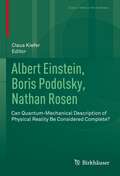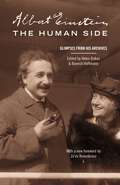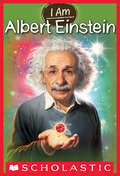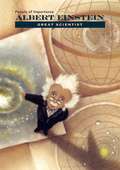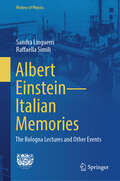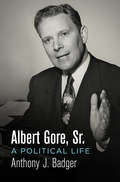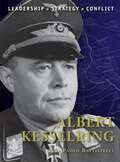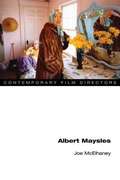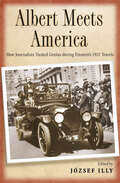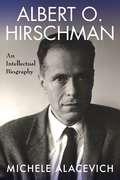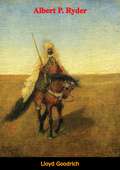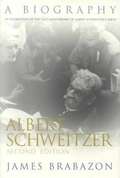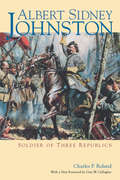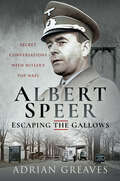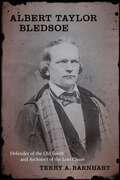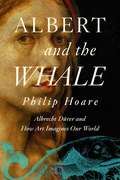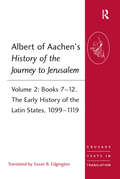- Table View
- List View
Albert Camus as Philosopher and Political Thinker: The Radicality of Modesty
by Tommaso VisoneThis book explores the role of modesty in the thought of Albert Camus. Camusian modesty – modestie – affirms, against nihilism and absolutism, the necessity of taking care and putting passion into the relativity of human creation and recreation. The book shows how this care and passion spring from the necessity of a continually renewed tension between the self and the limits which transcend the self. From this standpoint, modesty is not a form of moderation; it goes to the root of human condition in face of the absurd. It is a radical attitude which engages human life in a daily struggle for meaning. With modesty in mind, Camus reimagined the relation between meaning and absurdity, history and nature, self and other, nation state and continent, global north and south, and war and peace. In a world of arrogance, narcissism, and fear, Camus’ philosophical and political insights are fundamental in order to re-think and re-imagine our present.
Albert Camus as Political Thinker
by Samantha NovelloAn intense genealogical reconstruction of Camus's political thinking challenging the philosophical import of his writings as providing an alternative, aesthetic understanding of politics, political action and freedom outside and against the nihilistic categories of modern political philosophy and the contemporary politics of contempt and terrorisms
Albert Camus: Elements of a Life
by Robert D. ZaretskyLike many others of my generation, I first read Camus in high school. I carried him in my backpack while traveling across Europe, I carried him into (and out of) relationships, and I carried him into (and out of) difficult periods of my life. More recently, I have carried him into university classes that I have taught, coming out of them with a renewed appreciation of his art. To be sure, my idea of Camus thirty years ago scarcely resembles my idea of him today. While my admiration and attachment to his writings remain as great as they were long ago, the reasons are more complicated and critical.—Robert Zaretsky On October 16, 1957, Albert Camus was dining in a small restaurant on Paris's Left Bank when a waiter approached him with news: the radio had just announced that Camus had won the Nobel Prize for Literature. Camus insisted that a mistake had been made and that others were far more deserving of the honor than he. Yet Camus was already recognized around the world as the voice of a generation—a status he had achieved with dizzying speed. He published his first novel, The Stranger, in 1942 and emerged from the war as the spokesperson for the Resistance and, although he consistently rejected the label, for existentialism. Subsequent works of fiction (including the novels The Plague and The Fall), philosophy (notably, The Myth of Sisyphus and The Rebel), drama, and social criticism secured his literary and intellectual reputation. And then on January 4, 1960, three years after accepting the Nobel Prize, he was killed in a car accident. In a book distinguished by clarity and passion, Robert Zaretsky considers why Albert Camus mattered in his own lifetime and continues to matter today, focusing on key moments that shaped Camus's development as a writer, a public intellectual, and a man. Each chapter is devoted to a specific event: Camus's visit to Kabylia in 1939 to report on the conditions of the local Berber tribes; his decision in 1945 to sign a petition to commute the death sentence of collaborationist writer Robert Brasillach; his famous quarrel with Jean-Paul Sartre in 1952 over the nature of communism; and his silence about the war in Algeria in 1956. Both engaged and engaging, Albert Camus: Elements of a Life is a searching companion to a profoundly moral and lucid writer whose works provide a guide for those perplexed by the absurdity of the human condition and the world's resistance to meaning.
Albert Einstein (National Geographic Kids Readers)
by Libby RomeroExplore one of the most recognized scientists in the world with this biography of physicist Albert Einstein. Kids will learn about his life, achievements, and the challenges he faced along the way. The level 3 text provides accessible, yet wide-ranging, information for independent readers.
Albert Einstein Was a Dope? (Wait! What? #0)
by Dan GutmanFrom the best-selling author behind My Weird School: a quirky new biography series that casts fresh light on high-interest historic figures. Did you know that Albert Einstein was a high school dropout, and that he failed his physics class when he finally made it to college? Or that when he died, his brain and eyeballs were removed from his body? Ever wondered why his hair looked so wild? Siblings Paige and Turner do—and they’ve collected some of the kookiest and most unusual facts about the world-famous scientist, from his childhood and school days through his time studying relativity and working on the atomic bomb. Narrated by the two spirited siblings and animated by Allison Steinfeld’s upbeat illustrations, Albert Einstein Was a Dope? expertly balances authoritative information with Dan Gutman’s signature zany humor.
Albert Einstein – His Life and Science: A Dramatized Biography
by Ken K. ChinThis book is part biographical account, part novel, and part popular science. The basic facts are historically true, but many episodes have additionally been dramatized with plausible content that brings the personal story to life in the style of a novel or movie script. This genre of a “dramatized biography" of scientists was first created by the author 45 years ago and became a great success selling over half a million copies in China, where it has been in particular demand for teaching. But this is not the whole story: In addition, the book explains, in a serious yet accessible manner, the basics of Einstein’s scientific work, especially its impact on contemporary cosmology, astronomy, and physics. As an experienced teacher of relativity and astronomy for high-school and university students, the author knows how to make profound scientific subjects accessible, and his presentation is as fascinating as a detective story. Readers will learn not only about the historical setting but also about the challenges and frustrations faced by Einstein, about his breakthroughs and triumphs, as well as the far-reaching significance of his theory of relativity, quantum mechanics, and other scientific achievements. The reader will come to understand why, of all the billions of people living in the twentieth century, Albert Einstein was singled out as the “Person of the Century.”
Albert Einstein, Boris Podolsky, Nathan Rosen: Can Quantum-Mechanical Description of Physical Reality Be Considered Complete? (Classic Texts in the Sciences)
by Claus KieferThe work published by Einstein, Podolsky and Rosen (EPR) in 1935 is a classic in modern physics. It discusses, for the first time, the central feature of the quantum theory: entanglement. In general, systems are intertwined with each other in nature; that is, they have only one common, non-divisible state. This fact is responsible for all the oddities commonly associated with quantum theory, including the famous thought experiments with Schrödinger’s cat and Wigner’s friend. The entanglement of quantum mechanics plays a central role in experiments with atoms and photons (Nobel Prize 2012 for Haroche and Wineland) and the planned construction of quantum computers. This book presents EPR’s original work amplified with a detailed commentary, which examines both the historical context and all aspects of entanglement. In particular, it focuses on the interpretation of quantum theory and its consequences for a basic understanding of nature.
Albert Einstein, The Human Side: Glimpses from His Archives
by Albert EinsteinModesty, humor, compassion, and wisdom are the traits most evident in this illuminating selection of personal papers from the Albert Einstein Archives. The illustrious physicist wrote as thoughtfully to an Ohio fifth-grader, distressed by her discovery that scientists classify humans as animals, as to a Colorado banker who asked whether Einstein believed in a personal God. Witty rhymes, an exchange with Queen Elizabeth of Belgium about fine music, and expressions of his devotion to Zionism are but some of the highlights found in this warm and enriching book.
Albert Einstein: Albert Einstein (I Am #2)
by Grace NorwichMeet the scientist who changed the way we think about the universe!I am one of the most gifted minds that ever lived. I am a Nobel Prize–winning physicist. I was expelled from school as a young child. I am Albert Einstein.Learn all about this brilliant man whose scientific accomplishments are truly remarkable in this biography featuring:illustrations throughouta timelinean introduction to the other people you’ll meet in the bookmapssidebarsa top ten list of important things to know, and more
Albert Einstein: Great Scientist
by Anne Marie SullivanAs a child, Albert Einstein was quiet and awkward. He had trouble making friends and problems with learning in the classroom. As Albert grew up, he began to use his mind in ways he didn't learn in school, leading him to become an expert in math and science. Einstein's ideas helped change the way scientists thought of the world around us and change the course of history in the atomic age. Today, Einstein is one of history's most famous scientists, and his theories have shaped science for decades. Learn about one of the most important scientists of all time in Albert Einstein: Great Scientist.
Albert Einstein—Italian Memories: The Bologna Lectures and Other Events (History of Physics)
by Sandra Linguerri Raffaella Simili (deceased)This book is dedicated to Einstein’s personal and scientific relationships with Italy, which began as early as adolescence and continued over various stages of his life. It collects together a wealth of historical documentation including the letters in which Einstein recalls having lived as a young man with his family in Lombardy, Pavia and Milan; the texts of three lectures delivered by Einstein in Italian in October 1921 in Bologna at the invitation of the mathematician Federigo Enriques, the only lectures he held in Italy; the correspondence with Enriques and other Italian intellectuals, together with the letter that Einstein sent in 1931 to the Minister of Justice Alfredo Rocco to try to avoid the infamy of the oath of allegiance to the fascist regime imposed by Mussolini on university professors. The book closes with some writings on relativity from 1907 to 1914 (Einstein, Abraham, Corbino, Castelnuovo) and the 1920s debate between pro-relativists and anti-relativists publishedin the international journal “Scientia”, founded in 1907 by Enriques.
Albert Gore, Sr.: A Political Life (Politics and Culture in Modern America)
by Anthony J. BadgerIn chronicling the life and career of Albert Gore, Sr., historian Anthony J. Badger seeks not just to explore the successes and failures of an important political figure who spent more than three decades in the national eye—and whose son would become Vice President of the United States—but also to explain the dramatic changes in the South that led to national political realignment.Born on a small farm in the hills of Tennessee, Gore served in Congress from 1938 to 1970, first in the House of Representatives and then in the Senate. During that time, the United States became a global superpower and the South a two party desegregated region. Gore, whom Badger describes as a policy-oriented liberal, saw the federal government as the answer to the South's problems. He held a resilient faith, according to Badger, in the federal government to regulate wages and prices in World War II, to further social welfare through the New Deal and the Great Society, and to promote economic growth and transform the infrastructure of the South.Gore worked to make Tennessee the "atomic capital" of the nation and to protect the Tennessee Valley Authority, while at the same time cosponsoring legislation to create the national highway system. He was more cautious in his approach to civil rights; though bolder than his moderate Southern peers, he struggled to adjust to the shifting political ground of the 1960s. His career was defined by his relationship with Lyndon Johnson, whose Vietnam policies Gore bitterly opposed. The injection of Christian perspectives into the state's politics ultimately distanced Gore's worldview from that of his constituents. Altogether, Gore's political rise and fall, Badger argues, illuminates the significance of race, religion, and class in the creation of the modern South.
Albert Kesselring
by Adam Hook Pier BattistelliAlthough he is mostly remembered for his part in the campaign in Italy from 1943 to 1945, Generalfeldmarschall Albert Kesselring was also chief of staff of the Luftwaffe in 1936-37, playing a crucial role in the shaping of the service for the coming war. As commander of Luftflotte 1 in Poland and Luftflotte 2 in France and the Low Countries, he was responsible for supporting the armoured spearheads of the German Army as they undertook their Blitzkrieg campaigns. With the Fall of France, the Battle of Britain began and Luftlotte 2 was the main force in the air attack against the British air defences, with Kesselring planning many raids. Following the war Kesselring was tried and convicted of war crimes following a number of massacres of civilians in Italy. He was sentenced to death, later commuted to life imprisonment before being released on the grounds of ill health in October 1952. Here Pier Paolo Battistelli provides a detailed study of one of the most famous German commanders of World War II.
Albert Maysles (Contemporary Film Directors)
by Joe McelhaneyAlbert Maysles has created some of the most influential documentaries of the postwar period. Such films as Salesman,Gimme Shelter, and Grey Gardens continue to generate intense debate about the ethics and aesthetics of the documentary form. In this in-depth study, Joe McElhaney offers a novel understanding of the historical relevance of Maysles. By closely focusing on Maysles's expressive use of his camera, particularly in relation to the filming of the human figure, this book situates Maysles's films within not only documentary film history but film history in general, arguing for their broad-ranging importance to both narrative film and documentary cinema. Complete with an engaging interview with Maysles and a detailed comparison of the variant releases of his documentary on the Beatles (What's Happening: The Beatles in the U.S.A. and The Beatles: The First U.S. Visit), this work is a pivotal study of a significant filmmaker.
Albert Meets America: How Journalists Treated Genius during Einstein's 1921 Travels
by József IllyIn 1919, newspaper headlines said that a British expedition had confirmed Einstein's general theory of relativity. The news stirred the public imagination on both sides of the Atlantic and thrust the scientist into the spotlight of fame. Two years later, Chaim Weizmann led a fund-raising mission to the United States and invited Einstein to join it. The mission traveled to New York, Boston, Chicago, Cleveland, Philadelphia, and Hartford to campaign for public awareness and support of the Hebrew University of Jerusalem. This brought Einstein within the grasp of the American media. His lectures delivered in New York, Princeton, and Chicago, and comments on the Jewish presence in Palestine, made Einstein, on his first trip to America, one of the first media stars. In Albert Meets America, József Illy presents a fascinating compilation of media stories of Einstein’s tour—which cover his science, his Zionism, and the anti-Semitism he encountered. As we travel with Einstein, from headline to headline, we experience his emotional connection with American Jews and his frustration at becoming world famous even though his theories were not truly understood. This exciting collection gives readers an intimate glimpse into the life of one of the world’s first modern celebrities and a unique understanding of the media's power over both its subject and its audience.
Albert Meets America: How Journalists Treated Genius during Einstein's 1921 Travels
by József IllyThis volume of news articles from Einstein’s first trip to America explores his rise a public figure and the creation of his celebrity persona.When a British expedition confirmed Albert Einstein’s general theory of relativity in 1919, the news catapulted the German physicist to global fame. Two years later, he joined a fund-raising tour through the United States—a country he’d never seen before—gathering support for the Hebrew University of Jerusalem. His lectures in New York, Princeton, and Chicago, and comments on the Jewish presence in Palestine, made Einstein one of the first media stars. In Albert Meets America, József Illy presents a fascinating compilation of media stories written during Einstein’s trip that cover his science, his Zionism, and the anti-Semitism he encountered. Traveling with Einstein from headline to headline, readers experience his emotional connection with American Jews and his frustration at becoming world famous even though his theories were not truly understood.This collection gives readers an intimate glimpse into the life of one of the world’s first modern celebrities and a unique understanding of the media’s power over both its subject and its audience.
Albert O. Hirschman: An Intellectual Biography
by Michele AlacevichOne of the most original social scientists of the twentieth century, Albert O. Hirschman led an uncommonly dramatic life. After fleeing Nazi Germany as a youth, he fought in the Spanish Civil War, took part in antifascist activities in Italy, and organized an underground rescue operation in Marseille through which more than 2,000 people, including Marc Chagall, Arthur Koestler, and Hannah Arendt, escaped Europe. Hirschman moved across topics, methodologies, and disciplinary boundaries as fluidly as he did among countries and languages. His work is marked by a deep suspicion of all-encompassing theories, valuing instead doubt and a sensitivity to contingencies and unexpected consequences.In this intellectual biography, the economic historian Michele Alacevich explores the development and trajectory of Hirschman’s characteristic approach to social-scientific questions. He traces the many strands of Hirschman’s thought and their place in his multifaceted body of work, considering their limitations as well as their strengths. Alacevich puts Hirschman’s ideas into context, following his participation in the major intellectual and political debates of his times. He examines Hirschman’s pioneering work in development studies and his analyses of social change, the history of capitalism, and the workings of democracy alongside his activities in the postwar reconstruction of Europe and economic development in Latin America. A compelling intellectual portrait of a profoundly distinctive thinker, this book also reflects on Hirschman’s legacy and lasting influence.
Albert P. Ryder (The Great American Artists Series)
by Lloyd GoodrichAlbert Pinkham Ryder, along with Winslow Homer and Thomas Eakins, is recognized as one of the great “ancestors” of American painting, although he was largely unknown in his own time. Twentieth-century taste discovered him and his mystical pictures have had a profound effect on modern abstract art.Lloyd Goodrich is Director of the Whitney Museum of American Art under whose auspices his definitive biography of Thomas Eakins was published in 1933. For many years Mr. Goodrich has been carrying on research in the life and work of Albert P. Ryder, in preparation for a definitive biography. Since Ryder’s work has been widely forged, with the forgeries outnumbering the genuine pictures about eight to one, this study has involved examination of hundreds of paintings, using x-rays and other scientific methods. The present volume, originally published in 1959, has the advantage of these years of thorough study.
Albert Schweitzer: A Biography
by James BrabazonJames Brabazon updates his critically acclaimed biography of humanitarian Albert Schweitzer to include a wealth of recently discovered documents, including the letters between Schweitzer and Helene Bresslau written during the ten years before their marriage. Brabazon's research has also included recently released documents from the State Department regarding Schweitzer's battle with the United States Atomic Energy Commission to halt H-bomb tests.
Albert Schwenn's Memories of the Waffen-SS: An SS Cavalry Division Veteran Remembers
by Rolf Michaelis Albert SchwennA firsthand account from a member of the SS Cavalry Division, and SS Cavalry Training and Replacement Battalion
Albert Sidney Johnston: Soldier of Three Republics
by Charles P. RolandA biography of the man whom Jefferson Davis could have considered one of his greatest generals during the American Civil War. A revised edition of the only full-scale biography of the Confederacy&’s top-ranking field general during the opening campaigns of the Civil War. Albert Sidney Johnston was selected as one of the best one hundred books ever written on the Civil War by Civil War Times Illustrated in 1981 and by Civil War: The Magazine of the Civil War Society in 1995.Featuring a new forward by Gary W. Gallagher and a new preface by the author Praise for Albert Sidney Johnston &“A biography of the Kentucky native who might have been mentioned in the same breath as Robert E. Lee had Johnston not died while commanding Confederate troops at the battle of Shiloh in 1862, only a year after the war started.&”—Lexington Herald-Leader &“Johnston&’s early years, military career, and encounters with Indians, Mormons, and Union soldiers are the focus of this &“masterly&” study.&”—Civil War Book Review &“The view of army life and the terrible decisions that many southern officers had to make at the beginning will provide an excellent background for further understanding the Civil War.&”—Paper Wars
Albert Speer—Escaping the Gallows: Secret Conversations with Hitler's Top Nazi
by Adrian GreavesAt the Nuremberg War Crimes Tribunal, Albert Speer, Hitler’s one-time number two, persuaded the judges that he ‘knew nothing’ of the Holocaust and related atrocities. Narrowly escaping execution, he was sentenced to twenty years in Spandau Prison, Berlin. In 1961, the newly commissioned author, as the British Army Spandau Guard Commander, was befriended by Speer, who taught him German. Adrian Greaves’ record of his conversations with Speer over a three year period make for fascinating reading. While the top Nazi admitted to Greaves his secret part in war crimes, after his 1966 release he determinedly denied any wrongdoing and became an intriguing and popular figure at home and abroad. Following Speer’s death in 1981 evidence emerged of his complicity in Hitler’s and the Nazi’s atrocities. In this uniquely revealing book the author skilfully blends his own personal experiences and relationship with Speer with a succinct history of the Nazi movement and the horrors of the 1930s and 1940s. In so doing new light is thrown on the character of one of the 20th century’s most notorious characters.
Albert Taylor Bledsoe: Defender of the Old South and Architect of the Lost Cause (Southern Biography Series)
by Terry A. BarnhartAlbert Taylor Bledsoe (1809--1877), a principal architect of the South's "Lost Cause" mythology, remains one of the Civil War generation's most controversial intellectuals. In Albert Taylor Bledsoe: Defender of the Old South and Architect of the Lost Cause, Terry A. Barnhart sheds new light on this provocative figure.Bledsoe gained a respectable reputation in the 1840s and 1850s as a metaphysician and speculative theologian. His two major works, An Examination of President Edwards' Inquiry into the Freedom of the Will (1845) and A Theodicy; Or, Vindication of the Divine Glory, As Manifested in the Constitution and Government of the Moral World (1853), grapple with perplexing problems connected with causality, Christian theology, and moral philosophy. His fervent defense of slavery and the constitutional right of secession, however, solidified Bledsoe as one of the chief proponents of the idea of the Old South. In An Essay on Liberty and Slavery (1856), he assailed egalitarianism and promoted the institution of slavery as a positive good. A decade later, he continued to devote himself to fashioning the "Lost Cause" narrative as the editor and proprietor of the Southern Review from 1867 until his death in 1877. He carried on a literary tradition aimed to reconcile white southerners to what he and they viewed as the indignity of their defeat by sanctifying their lost cause. Those who fought for the Confederacy, he argued, were not traitors but honorable men who sacrificed for noble reasons.This biography skillfully weaves Bledsoe's extraordinary life history into a narrative that illustrates the events that shaped his opinions and influenced his writings. Barnhart demonstrates how Bledsoe still speaks directly, and sometimes eloquently, to the core issues that divided the nation in the 1860s and continue to haunt it today.
Albert and the Whale: Albrecht Dürer and How Art Imagines Our World
by Philip HoareAn illuminating exploration of the intersection between life, art and the sea from the award-winning author of The Whale.In 1520, Albrecht Dürer, the most celebrated artist in Northern Europe, sailed to Zeeland to see a whale. A central figure of the Renaissance, no one had painted or drawn the world like him. Dürer drew hares and rhinoceroses in the way he painted saints and madonnas. The wing of a bird or the wing of an angel; a spider crab or a bursting star like the augury of a black hole, in Dürer's art, they were part of a connected world. Everything had meaning. But now he was in crisis. He had lost his patron, the Holy Roman Emperor. He was moorless and filled with wanderlust. In the shape of the whale, he saw his final ambition. Dürer was the first artist to truly employ the power of reproduction. He reinvented the way people looked at, and understood, art. He painted signs and wonders; comets, devils, horses, nudes, dogs, and blades of grass so accurately that even today they seem hyper-real, utterly modern images. Most startling and most modern of all, he painted himself, at every stage of his life. But his art captured more than the physical world, he also captured states of mind. Albert and the Whale explores the work of this remarkable man through a personal lens. Drawing on Philip&’s experience of the natural world, and of the elements that shape our contemporary lives, from suburbia to the wide open sea, Philip will enter Dürer's time machine. Seeking his own Leviathan, Hoare help us better understand the interplay between art and our world in this sublimely seductive book.
Albert of Aachen's History of the Journey to Jerusalem: Books 7-12. The Early History of the Latin States, 1099-1119
by Susan B. EdgingtonAlbert of Aachen’s History of the Journey to Jerusalem presents the story of the First Crusade (1095-1099) and the first generation of Latin settlers in the Levant (1099-1119). Volume 2, The Early History of the Latin States, provides a surprising level of detail about the reign of King Baldwin I (1100-1118), especially its earlier years and the crusading expeditions of 1101. It offers much more information than the only other substantial Latin account of the same events, by Fulcher of Chartres, and where it can be tested against other narratives, including Arabic and Greek sources, it proves to be worthy of both trust and respect. Susan B. Edgington’s English translation has been widely praised, following its first publication in the Oxford Medieval Texts series, and is here presented with a new introduction and updated notes and bibliography.


